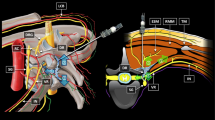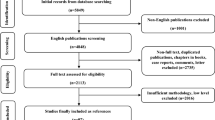Abstract
Introduction and objective
Renal colic is one of the most intense pains known to humans. Standard treatment usually consists of nonsteroidal anti-inflammatory drugs and opiates, but they do not always provide optimum efficacy and speed in relieving the pain. For more than 25 years, our hospital has been employing twelfth subcostal nerve block. The objective of the present study was to compare the efficacy of subcostal nerve block with lidocaine versus intramuscular diclofenac in renal colic management.
Methods
Sixty patients of both sexes, above the age of 18 years, and presenting with renal colic were randomly selected for the study. The visual analog scale was applied prior to the treatment and at minutes 1, 3, 5, 30, and 45 after the application of the twelfth nerve block or the intramuscular administration of diclofenac.
Results
A total of 60 patients, 35 women and 25 men, were included in the study. There were statistically significant differences in the mean scores for pain from minute 1 to minute 45. There were no adverse effects.
Conclusions
Twelfth Subcostal nerve block with lidocaine is an efficacious, safe, inexpensive, and very fast-acting medication for pain control related to renal colic. These characteristics make it superior to diclofenac.


Similar content being viewed by others
References
Esquena S, Millan Rodriguez F, Sanchez-Martin FM, Rousaud Baron F, Marchant F, Villavicencio Mavrich H (2006) Renal colic: revision of literature and scientific evidence. Actas Urol Esp 30(3):268–280
Leveridge M, D’Arcy FT, O’Kane D, Ischia JJ, Webb DR, Bolton DM et al (2016) Renal colic: current protocols for emergency presentations. Eur J Emerg Med 23(1):2–7
Shokeir AA (2002) Renal colic: new concepts related to pathophysiology, diagnosis and treatment. Curr Opin Urol 12(4):263–269
Pedersen KV, Drewes AM, Frimodt-Moller PC, Osther PJ (2010) Visceral pain originating from the upper urinary tract. Urol Res 38(5):345–355
Burnstock G (2009) Purinergic mechanosensory transduction and visceral pain. Mol Pain 5:69
Bultitude M, Rees J (2012) Management of renal colic. BMJ 345:e5499
Knoedler JJ, Lieske JC (2016) Non-steroidal anti-inflammatory drugs for renal colic. Lancet 387(10032):1971–1972
Türk C, Petřík A, Sarica K, Seitz C, Skolarikos A, Straub M, Knoll T (2012) EAU guidelines on diagnosis and conservative management of urolithiasis. Eur Urol 69(3):468–474
Davenport K, Timoney AG, Keeley FX (2005) Conventional and alternative methods for providing analgesia in renal colic. BJU Int 95(3):297–300
Sivrikaya A, Celik OF, Sivrikaya N, Ozgur GK (2003) The effect of diclofenac sodium and papaverine on isolated human ureteric smooth muscle. Int Urol Nephrol 35(4):479–483
Garduño AL, García IC, González RR (1993) Bloqueo del duodécimonervio intercostal como tratamiento del cólico renoureteral. Rev Mex Urol. 53(4):74–79
Aragon TA, Reyes VF, Herrera G, Manjarrez EG, Gutierrez PC (1994) Eficacia del bloqueo subcostal como tratamiento del cólico nefritico. Rev Mex Urol. 54(5):91–98
Nikiforov S, Cronin AJ, Murray WB, Hall VE (2001) Subcutaneous paravertebral block for renal colic. Anesthesiology 94(3):531–532
Iguchi M, Katoh Y, Koike H, Hayashi T, Nakamura M (2002) Randomized trial of trigger point injection for renal colic. Int J Urol 9(9):475–479
Shokeir AA (2001) Renal colic: pathophysiology, diagnosis and treatment. Eur Urol 39(3):241–249
Afshar K, Jafari S, Marks AJ, Eftekhari A, MacNeily AE (2015) Nonsteroidal anti-inflammatory drugs (NSAIDs) and non-opioids for acute renal colic. Cochrane Database Syst Rev 2015(6):CD006027
Pathan SA, Mitra B, Straney LD, Afzal MS, Anjum S, Shukla D et al (2016) Delivering safe and effective analgesia for management of renal colic in the emergency department: a double-blind, multigroup, randomised controlled trial. Lancet 387(10032):1999–2007
KandaSwamy GV, Dhanasekaran AK, Elangovan A, John B, Viswaroop B, Vedanayagam KS (2015) Randomized double blinded placebo controlled trial comparing diclofenac and piroxicam in management of acute renal colic and its clinical implications. Urol J 12(2):2069–2073
Kaynar M, Koyuncu F, Buldu I, Tekinarslan E, Tepeler A, Karatag T et al (2015) Comparison of the efficacy of diclofenac, acupuncture, and acetaminophen in the treatment of renal colic. Am J Emerg Med 33(6):749–753
Firouzian A, Alipour A, Rashidian-Dezfouli H, Zamani-Kiasari A, Gholipour-Baradari A, Emami-Zeydi A et al (2016) Does lidocaine as an adjuvant to morphine improve pain relief in patients presenting to the ED with acute renal colic? A double-blind randomized controlled trial. Am J Emerg Med 34(3):443–448
Hura G, Knapik P, Sorek-Kubicka G, Maciejewski D (2005) Thoracic paravertebral blockade–history or present time? Wiad Lek 58(3–4):208–211
Rossikhin VV (1978) Effectiveness of M.N. Astvatsaturov’s block in renal colic. Klin Khir 2:74–75
Puterman NS (1973) Treatment of the renal colic. Vestn Khir Im I I Grek 110(3):113–114
Eken C, Durmaz D, Erol B (2009) Successful treatment of a persistent renal colic with trigger point injection. Am J Emerg Med 27(2):252-e3
Belkouch A, Zidouh S, Rafai M, Chouaib N, Sirbou R, Elbouti A et al (2015) Does intranasal fentanyl provide efficient analgesia for renal colic in adults? Pan Afr Med J 20:407
Benitez Camps M, Cerain Herrero MJ, de Miguel Llorente N, Martorell Sole E, Flores Mateo G, Pedro Pijoan AM et al (2015) Tamsulosin efficacy and safety for conservative management of renal colic: systematic review and meta-analysis of randomized controlled trials. Med Clin 145(6):239–247
el-Sherif AE, Salem M, Yahia H, al-Sharkawy WA, al-Sayrafi M (1995) Treatment of renal colic by desmopressin intranasal spray and diclofenac sodium. J Urol 153(5):1395–1398
Pricop C, Branisteanu DD, Orsolya M, Puia D, Matei A, Checherita IA (2016) Sublingual desmopressin is efficient and safe in the therapy of lithiasic renal colic. Int Urol Nephrol 48(2):183–189
Faridaalaee G, Mohammadi N, Merghati SZ, Keyghobadi Khajeh F, Naghipour B, Pouraghaei M et al (2016) Intravenous morphine vs intravenous ketofol for treating renal colic; a randomized controlled trial. Emergency. 4(4):202–206
Mora B, Giorni E, Dobrovits M, Barker R, Lang T, Gore C et al (2006) Transcutaneous electrical nerve stimulation: an effective treatment for pain caused by renal colic in emergency care. J Urol 175(5):1737–1741 (discussion 41)
Lee YH, Lee WC, Chen MT, Huang JK, Chung C, Chang LS (1992) Acupuncture in the treatment of renal colic. J Urol 147(1):16–18
Melzack R, Stillwell DM, Fox EJ (1977) Trigger points and acupuncture points for pain: correlations and implications. Pain 3(1):3–23
Fine PG, Milano R, Hare BD (1988) The effects of myofascial trigger point injections are naloxone reversible. Pain 32(1):15–20
Wyant GM (1979) Chronic pain syndromes and their treatment. II. Trigger points. Can Anaesth Soc J 6(3):216–219
Author information
Authors and Affiliations
Corresponding author
Ethics declarations
Conflict of interest
None.
Ethical approval and informed consent
The research protocol for this study was approved by the research committee of our institution (Registration Number DI/14/105/04/047), and it was found to adhere to the rules of good clinical practice.
Rights and permissions
About this article
Cite this article
Maldonado-Avila, M., Del Rosario-Santiago, M., Rosas-Nava, J.E. et al. Treatment of reno-ureteral colic by twelfth intercostal nerve block with lidocaine versus intramuscular diclofenac. Int Urol Nephrol 49, 413–417 (2017). https://doi.org/10.1007/s11255-016-1479-5
Received:
Accepted:
Published:
Issue Date:
DOI: https://doi.org/10.1007/s11255-016-1479-5




